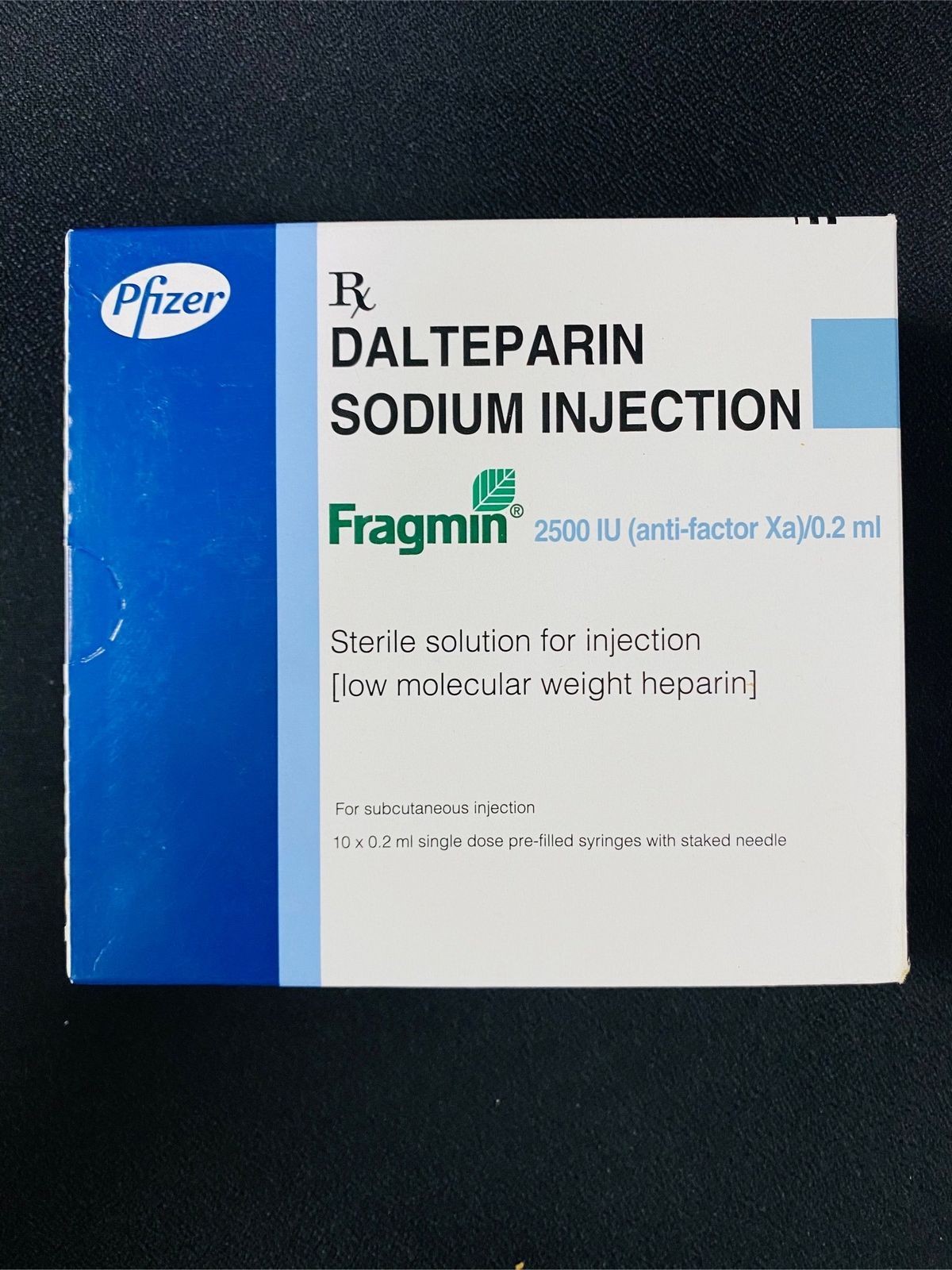
Contents
- 1 dalteparin injection (Fragmin)
- 1.0.1 What are the side effects of dalteparin injection?
- 1.0.2 What is the dosage for dalteparin injection?
- 1.0.3 Which drugs or supplements interact with dalteparin injection?
- 1.0.4 Is dalteparin injection safe to take if I’m pregnant or breastfeeding?
- 1.0.5 What else should I know about dalteparin injection?
- 1.0.6 Summary
- 1.0.7 Related Disease Conditions
- 1.1 Blood Clots (in the Leg)
- 1.2 Itch (Itching or Pruritus)
- 1.3 Stress
- 1.4 Dandruff (Seborrhea)
- 1.5 Psoriasis
- 1.6 Pulmonary Embolism (Blood Clot in the Lung)
- 1.7 Heart Attack (Myocardial Infarction)
- 1.8 Deep Vein Thrombosis (DVT, Blood Clot in the Legs)
- 1.9 Hair Loss (Alopecia) In Men and In Women
- 1.10 Atrial Fibrillation (AFib) Treatment Drugs
- 1.11 Angina
dalteparin injection (Fragmin)
Dalteparin is a low molecular weight heparin (LMWH) similar to enoxaparin (Lovenox) and tinzaparin. It is used to treat or prevent blood clots and their complications (deep vein thrombosis or DVT and pulmonary embolism or PE). DVT is the formation of blood clots in veins deep in a muscle, most often in the legs. DVT may lead to PE, a condition in which a piece of the clot (the embolus) breaks loose and travels to the lung. In the lung, the clot blocks an artery and prevents normal lung function. If the blocked artery is large, the embolus can cause sudden death. Patients undergoing hip replacement and other major surgery are at increased risk of DVT and PE. Dalteparin, like other LMWHs, prevents clot formation by accelerating the breakdown of clotting factors Xa and IIa (thrombin) by antithrombin III. Unfractionated heparin, unlike LMWHs, also breaks down clotting factors IX, XI, XII, and plasmin. The effect of dalteparin does not need to be monitored with blood tests. The FDA approved dalteparin in December 1994.
What brand names are available for dalteparin injection?
Is dalteparin injection available as a generic drug?
Do I need a prescription for dalteparin injection?
What are the side effects of dalteparin injection?
The most frequent adverse reactions are:
- bleeding,
- drop in platelet count,
- bruising,
- pain at injection site, and
- increase in certain factors in liver function tests.
An immune reaction resulting in a drop in platelets and clotting (heparin-induced thrombocytopenia) is very rare and significantly lower than with heparin use. LMWHs should be avoided in patients with epidural or spinal punctures as there is significant risk of spinal or epidural hematomas resulting in paralysis.
What is the dosage for dalteparin injection?
To prevent blood clots in immobile patients at risk for clots or high-risk patients undergoing abdominal surgery or hip replacement, the dose is 5000 units subcutaneously (SQ) once daily. In low-risk abdominal surgery patients, the dose is 2500 units SQ once daily. To treat clots in cancer patients, the dose is 200 units per kg weight SQ once daily (max 18,000 units) for month 1, followed by 150 units per kg weight SQ once daily (max 18,000 units) during months 2 to 6. To treat clots in unstable angina or heart attack, the dose is 120 units per kg weight (max 10,000 units) every 12 hours.
Which drugs or supplements interact with dalteparin injection?
Combining dalteparin with other blood thinning agents may increase the risk of severe bleeding. Dalteparin should not be combined with urokinase or other anticoagulants such as apixaban (Eliquis), dabigatran (Pradaxa), and rivaroxaban (Xarelto). Therapy should be monitored when used with platelet inhibitors (such as aspirin and clopidogrel [Plavix]), serotonin reuptake inhibitors (such as sertraline [Zoloft] and fluoxetine [Prozac, Sarafem, Prozac Weekly]), and nonsteroidal anti-inflammatory drugs (such as ibuprofen). Dalteparin may increase potassium levels, so caution with and monitoring of potassium levels is advised with drugs such as ACE inhibitors (for example, lisinopril [Zestril, Prinivil]), angiotensin II receptor blockers (for example, losartan [Cozaar]), and other drugs like aliskiren, spironolactone (Aldactone), eplerenone, and potassium salts.
Is dalteparin injection safe to take if I’m pregnant or breastfeeding?
Adverse effects were not observed in animal studies, as LMWHs do not cross the placenta. LMWHs are preferred over unfractionated heparin and warfarin (Coumadin) in pregnant women. Agents should be discontinued at least 24 hours before planned delivery.
Dalteparin enters breast milk, though oral absorption by the infant is extremely low. The effect of this low level of exposure on the infant is unknown.
What else should I know about dalteparin injection?
What preparations of dalteparin injection are available?
- Single-dosed prefilled syringe: 2500 units (u)/0.2 mL, 5000 u/0.2 mL, 7500 u/0.3 mL, 12,500 u/0.5 mL, 15,000 u/0.6 mL, 18,000 u/0.72 mL
- Single-dose graduated syringe: 10,000 u/mL
- Multiple dose vial: 95,000 u/9.5 mL, 95,000u/3.8 mL
How should I keep dalteparin injection stored?
Store at room temperature, between 20 C to 25 C (68 F to 77 F).
Summary
Dalteparin injection (Fragmin) is prescribed to prevent blood clots in specific patients, to prevent DVT after hip replacement or abdominal surgery, in immobile patients, and some cancer and non-cancer patients. Side effects, drug interactions, dosage, and pregnancy safety should be reviewed prior to taking this medication.
Related Disease Conditions
Blood Clots (in the Leg)
Blood clots can form in the heart, legs, arteries, veins, bladder, urinary tract, and uterus. Risk factors include high blood pressure and cholesterol, diabetes, smoking, and family history. Symptoms and treatment depend on the location of the clot.
Itch (Itching or Pruritus)
Itching can be a common problem. Itches can be localized or generalized. There are many causes of itching including infection (jock itch, vaginal itch), disease (hyperthyroidism, liver or kidney), reactions to drugs, and skin infestations (pubic or body lice). Treatment for itching varies depending on the cause of the itch.
Stress
Stress is a normal part of life, but chronic or severe stress can be harmful to your health. Learn what happens in your body when you are stressed and how you can manage your response.
Dandruff (Seborrhea)
Dandruff (seborrhea) is a skin disorder that results from neither too much moisture nor too much oil. Dandruff can be treated with shampoos that contain tar, salicylic acid, zinc, selenium sulfide, or ketoconazole.
Psoriasis
Psoriasis is a long-term skin condition that may cause large plaques of red, raised skin, flakes of dry skin, and skin scales. There are several types of psoriasis, including psoriasis vulgaris, guttate psoriasis, inverse psoriasis, and pustular psoriasis. Symptoms vary depending on the type of psoriasis the patient has. Treatment of psoriasis may include creams, lotions, oral medications, injections and infusions of biologics, and light therapy. There is no cure for psoriasis.
Pulmonary Embolism (Blood Clot in the Lung)
A pulmonary embolism (PE) occurs when a piece of a blood clot from DVT breaks off and travels to an artery in the lung where it blocks the artery and damages the lung. The most common symptoms of a pulmonary embolism are shortness of breath, chest pain, and a rapid heart rate. Causes of pulmonary embolism include prolonged immobilization, certain medications, smoking, cancer, pregnancy, and surgery. Pulmonary embolism can cause death if not treated promptly.
Heart Attack (Myocardial Infarction)
A heart attack occurs when a blood clot completely obstructs a coronary artery supplying blood to the heart muscle. Learn about warning signs, causes, complications, risk factors, and treatment.
Deep Vein Thrombosis (DVT, Blood Clot in the Legs)
Deep vein thrombosis (DVT) is a blood clot in the deep veins and can be caused by broken bones, trauma to a limb, immobility, medications, smoking, cancer, genetic predisposition, and pregnancy. Symptoms and signs of a deep vein thrombosis in a leg are swelling, tenderness, redness, warmth, and pain. Treatments for DVT include medications and surgery.
Hair Loss (Alopecia) In Men and In Women
There are many causes of scalp hair loss. This featured article covers the common ones such as patchy hair loss (alopecia areata, trichotillomania, and tinea capitis), telogen effluvium, and androgenetic alopecia (male-pattern baldness, female-pattern baldness).
Atrial Fibrillation (AFib) Treatment Drugs
Atrial fibrillation (AFib) is a heart rhythm disorder that causes irregular and often rapid heartbeat. The medications to treat AFib include beta-blockers, blood thinners, and heart rhythm drugs. Atrial fibrillation drugs can cause serious side effects like seizures, vision changes, shortness of breath, fainting, other abnormal heart rhythms, excessive bleeding while coughing or vomiting, blood in the stool, and bleeding into the brain.
Angina
Angina is chest pain due to inadequate blood supply to the heart. Angina symptoms may include chest tightness, burning, squeezing, and aching. Coronary artery disease is the main cause of angina but there are other causes. Angina is diagnosed by taking the patient’s medical history and performing tests such as an electrocardiogram (EKG), blood test, stress test, echocardiogram, cardiac CT scan, and heart catheterization. Treatment of angina usually includes lifestyle modification, medication, and sometimes, surgery. The risk of angina can be reduced by following a heart healthy lifestyle.


